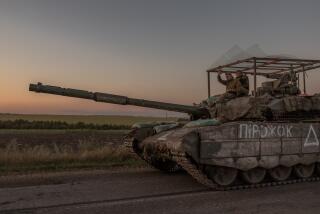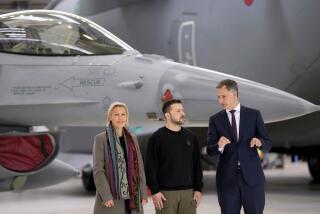Delivery of Tanks to Pakistan Sets Off Sales War With Russia
- Share via
KIEV, Ukraine — With its infrared night-vision optics, antiaircraft machine guns and desert-storming diesel engine, the T-80UD tank is a formidable assault weapon.
And when a contingent of them recently trundled through Islamabad, it signaled a Ukrainian conquest--but not by force of arms. The tanks displayed during a military parade had invaded a market, with a $600-million contract for Ukraine to sell 320 T-80UDs to Pakistan.
It is Kiev’s biggest arms sale to date. But officials are still cagey about it. They have cause for concern. Pakistan’s first major purchase of land weapons from a former Soviet republic has raised hackles in Russia, whose factories produce many of the parts that Ukraine’s factories assemble into T-80UDs.
Soon after the first 15 tanks arrived in Pakistan, Russia announced that it would not license export of any more T-80UD parts to Ukraine. The official reason: Moscow is actively pursuing arms sales to Islamabad’s chief rival, India.
A source at Rosvooryzhenye, Russia’s state-owned weapons dealer, told Interfax news agency that Russia “strictly refrains” from selling arms to Pakistan. But the T-80UD sale puts it in the “ambiguous position” of supplying weapons parts destined for that very country.
Officials and analysts here, however, suspect that the real reason for the embargo is to block Kiev’s new challenge to Moscow’s near-monopoly on arms exports from the region.
“Russia cut off the supply of parts, thinking Ukraine won’t be able to fulfill the contract alone,” says lawmaker Serhiy Sobelev, head of parliament’s Reform faction. “It wants the Pakistan contract for itself.”
The growing rivalry between the Slavic neighbors over shrinking international weapons markets was evident in March at the world’s largest arms fair, the International Defense Exhibition, in Abu Dhabi, capital of the United Arab Emirates. Judging by each country’s newspaper reports, Ukrainian and Russian arms dealers were elbowing each other aside to draw attention to their weapons.
One Ukrainian paper closely tied to President Leonid D. Kuchma proclaimed: “Ukraine is the only post-Soviet republic that can compete with Russia in the arms market.”
Meanwhile, a Russian daily happily described the crowds at its country’s exhibit and underscored former Soviet republics’ reliance on Russian-made parts for their weapons production. That dependence is a leftover from Soviet times, when weapons assembled here depended on other republics, especially Russia, for 80% of their parts.
Today, the percentage is smaller, though the specific proportions depend on the arms system. The top-of-the-line T-84 tank is 80% Ukrainian-made, while the T-80UD is, in the words of Ukrainian national security advisor Volodymyr Horbulin, “a largely Russian” product.
Some officials, citing Russia’s own dependence on Ukrainian-made parts--especially for its space program--hinted at a counter-embargo.
But Kuchma’s administration refuses to consider losing such potentially lucrative business. Instead, Hryhori Maliuk, director of the Kharkiv-based Malyshev tank factory--the biggest in the former Soviet Union--announced that the next consignment of 35 T-80UDs would be cobbled together from old tanks and parts from former Eastern Bloc countries such as Poland.
But cannibalizing existing tanks won’t be enough to arm the hundreds of additional T-80UDs that Ukraine must deliver over the next three years. Instead, its struggling military industry is doing what lawmakers such as Sobelev believe that it should have been doing all along: giving its own jobless factories work and ending reliance on Russia in a sensitive security matter such as arms production.
Factories all over the country’s depressed, industrialized east are switching into high gear, testing prototypes and developing mass production of artillery systems, engine batteries and optical systems to replace the Russian-made parts.
More to Read
Sign up for Essential California
The most important California stories and recommendations in your inbox every morning.
You may occasionally receive promotional content from the Los Angeles Times.













